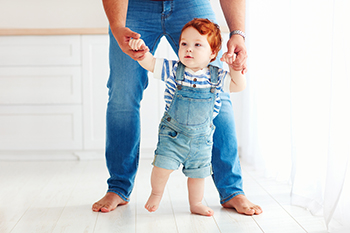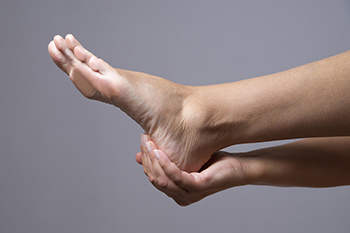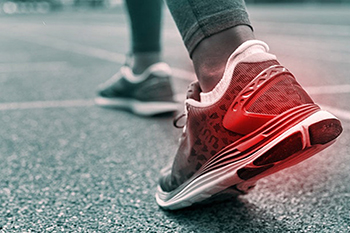Town Square Family Foot Care has permanently closed.
Dr. Scholz has accepted a position as a Podiatrist in the Department of Orthopedics and Rehabilitation at University of Iowa Health Care. If you’d like to schedule an appointment, call 319-356-2223.
If you would like to have your records sent to another provider, please send a record release form found on our website, 341foot.com, to our secure email contactus@341foot.net.
Blog
Items filtered by date: January 2023
When Should Your Baby Be Walking?

It’s hard to pinpoint exactly when a baby should be walking because they develop at different times. Many babies begin walking as early at 8 or 9 months, while others who are so-called late-bloomers may not begin until 16 months. Generally speaking, about half of babies have begun to take steps around 1 year old. The three factors that go into the process include muscle strength, balance, and temperament. The latter is the factor that most affects the age at which your baby will walk, experts say. Some babies continue to crawl because they can move faster than if they try to stand and walk. Early walkers can be more driven to try new motor skills, and lean babies often begin to walk earlier. Most babies simply decide for themselves when they are ready to walk, studies show. If you notice that your baby has certain foot gait abnormalities, such as pigeon-toed, walking on tiptoe, or duck walking, it is a good idea to see a podiatrist for an examination and discussion on possible treatment.
Making sure that your children maintain good foot health is very important as they grow. If you have any questions, contact Jill Scholz, DPM of Town Square Family Foot Care. Our doctor can provide the care you need to keep you pain-free and on your feet.
Keeping Children's Feet Healthy
Having healthy feet during childhood can help prevent medical problems later in life, namely in the back and legs. As children grow, their feet require different types of care. Here are some things to consider...
Although babies do not walk yet, it is still very important to take care of their feet.
Avoid putting tight shoes or socks on his or her feet.
Allow the baby to stretch and kick his or her feet to feel comfortable.
As a toddler, kids are now on the move and begin to develop differently. At this age, toddlers are getting a feel for walking, so don’t be alarmed if your toddler is unsteady or ‘walks funny’.
As your child gets older, it is important to teach them how to take care of their feet.
Show them proper hygiene to prevent infections such as fungus.
Be watchful for any pain or injury.
Have all injuries checked by a doctor as soon as possible.
Comfortable, protective shoes should always be worn, especially at play.
If you have any questions please feel free to contact our office located in Coralville, IA . We offer the newest diagnostic and treatment technologies for all your foot and ankle needs.
Babies, Adults, and Flat Feet

Flat feet is a condition that babies are born with. The arch typically develops during the teenage years in the majority of people, yet fails to do so in some adults. It is easy to tell if you have flat feet. Simply stand with your feet flat on the floor. People who do not have an arch will notice their entire foot rolls inward, and some patients may feel pain from it. If a considerable amount of walking is done, the foot may ache, and custom-made orthotics may be an option for pain relief. Flat feet often happen for genetic reasons, and may occur, although rarely, from improper foot growth in the womb. People who have gained weight may find that they have become flat footed from the additional weight the feet must endure. In severe cases, surgery may be required to build or restore the arch. If you have flat feet, please speak with a podiatrist who can accurately determine the extent of this condition, and offer treatment options, if needed, that are correct for you.
Flatfoot is a condition many people suffer from. If you have flat feet, contact Jill Scholz, DPM from Town Square Family Foot Care. Our doctor will treat your foot and ankle needs.
What Are Flat Feet?
Flatfoot is a condition in which the arch of the foot is depressed and the sole of the foot is almost completely in contact with the ground. About 20-30% of the population generally has flat feet because their arches never formed during growth.
Conditions & Problems:
Having flat feet makes it difficult to run or walk because of the stress placed on the ankles.
Alignment – The general alignment of your legs can be disrupted, because the ankles move inward which can cause major discomfort.
Knees – If you have complications with your knees, flat feet can be a contributor to arthritis in that area.
Symptoms
- Pain around the heel or arch area
- Trouble standing on the tip toe
- Swelling around the inside of the ankle
- Flat look to one or both feet
- Having your shoes feel uneven when worn
Treatment
If you are experiencing pain and stress on the foot you may weaken the posterior tibial tendon, which runs around the inside of the ankle.
If you have any questions please feel free to contact our office located in Coralville, IA . We offer the newest diagnostic and treatment technologies for all your foot and ankle needs.
Causes of Arch Pain in the Foot

The longitudinal arch of the foot, which extends from the heel to the base of the toes, plays a vital role in keeping you on your feet. This arch acts like a shock absorber and helps you maintain balance with every step you take. It also helps you adapt to changes in terrain, such as walking on a hilly or uneven surface. Most importantly, the arch bears the weight of your body when you stand or move. The arch is part of a complex network of muscles, ligaments, tendons, and bones that allow the feet to work efficiently. If any part of the network is injured, it often results in arch pain. Symptoms are tightness, pulling, or a burning sensation. The most common causes of arch pain are plantar fasciitis, flat feet, overpronation, and shoes that do not fit properly. Other causes are high arches, injury, and overuse. If symptoms of arch pain persist or worsen, it is a good idea to consult a podiatrist who can determine the cause and offer the appropriate treatment options.
If you have any concerns about your feet, contact Jill Scholz, DPM from Town Square Family Foot Care. Our doctor can provide the care you need to keep you pain-free and on your feet.
Biomechanics in Podiatry
Podiatric biomechanics is a particular sector of specialty podiatry with licensed practitioners who are trained to diagnose and treat conditions affecting the foot, ankle and lower leg. Biomechanics deals with the forces that act against the body, causing an interference with the biological structures. It focuses on the movement of the ankle, the foot and the forces that interact with them.
A History of Biomechanics
- Biomechanics dates back to the BC era in Egypt where evidence of professional foot care has been recorded.
- In 1974, biomechanics gained a higher profile from the studies of Merton Root, who claimed that by changing or controlling the forces between the ankle and the foot, corrections or conditions could be implemented to gain strength and coordination in the area.
Modern technological improvements are based on past theories and therapeutic processes that provide a better understanding of podiatric concepts for biomechanics. Computers can provide accurate information about the forces and patterns of the feet and lower legs.
Understanding biomechanics of the feet can help improve and eliminate pain, stopping further stress to the foot.
If you have any questions please feel free to contact our office located in Coralville, IA . We offer the newest diagnostic and treatment technologies for all your foot and ankle needs.
Styles of Running Can Determine What Type of Shoe Is Worn

Choosing running shoes that fit well can be a daunting task. It can help to decide what kind of running is desired and find shoes that are a match. There are various types of running surfaces, including trails, roads, and treadmills. In addition to that, it is beneficial for the running style to be considered which can be racing, casual, or long-distance. Shoes that are made for road running often have extra cushioning and must be able to handle running on a hard surface. Trail running requires shoes that have more traction than other shoes and this can make it easier to run on dirt, mud, or rocks. Many people choose to wear lighter shoes if treadmill running is their style. This lighter type of shoe may have less cushioning. To ensure a proper fit for any type of running the foot must be accurately measured. This is done by combining the width of the shoe, the heel fit, and the instep. If you would like additional information about how to choose the right running shoes, please consult with a podiatrist.
If you are a runner, wearing the right running shoe is essential. For more information, contact Jill Scholz, DPM from Town Square Family Foot Care. Our doctor can provide the care you need to keep you pain-free and on your feet.
Choosing the Right Running Shoe for Your Foot Type
To increase performance and avoid the risk of injury, it is important to choose the right running shoe based on your foot type. The general design of running shoes revolves around pronation, which is how the ankle rolls from outside to inside when the foot strikes the ground.
- Neutral runners are able to choose from a wide variety of shoes, including minimalist shoes or even going barefoot.
- Runners who overpronate, or experience an over-abundance of ankle rolling, should choose shoes that provide extra motion control and stability.
- Runners who underpronate, or supinate, have feet that have high arches and lack flexibility, preventing shock absorption. They require shoes with more flexibility and cushion.
If you have any questions please feel free to contact our office located in Coralville, IA . We offer the newest diagnostic and treatment technologies for all your foot and ankle needs.
Blog Archives
- February 2025
- January 2025
- December 2024
- November 2024
- October 2024
- September 2024
- August 2024
- July 2024
- June 2024
- May 2024
- April 2024
- March 2024
- February 2024
- January 2024
- December 2023
- November 2023
- October 2023
- September 2023
- August 2023
- July 2023
- June 2023
- May 2023
- April 2023
- March 2023
- February 2023
- January 2023
- December 2022